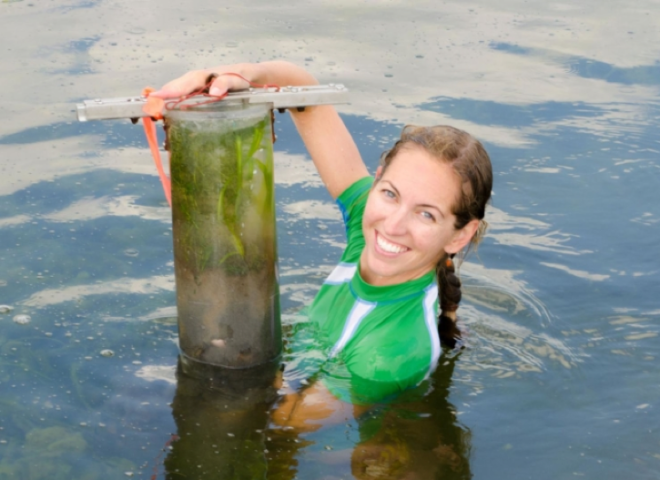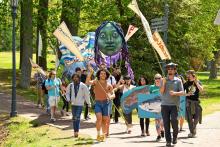
St. Mary’s College of Maryland Assistant Professor of Environmental Studies Cassie Gurbisz was among 18 co-authors of a new research article published in Nature Geoscience titled “Chesapeake Bay Acidification Buffered by Spatially-Decoupled Carbonate Mineral Cycling.”
The study reveals that submersed aquatic vegetation – also known as SAV or bay grass – provides a previously unknown benefit to coastal systems like the Chesapeake Bay by helping to make water in other parts of the estuary less acidic. This can help protect living resources like oysters, which have trouble building their shell when acidity increases due to nutrient pollution.
The research team initially set out to better understand the role of estuaries in the global carbon cycle by measuring chemical properties of the water along the length of the Chesapeake Bay. However, their data showed some unexpected changes in alkalinity, a measure of the acid-neutralizing capacity of water, that couldn’t be explained by physical mixing or known chemical and biological processes. They found that alkalinity decreased at the head of the bay, near extensive SAV beds in a region known as Susquehanna Flats. It then increased further south, indicating that some of the acidic water in the mid and lower bay was likely being neutralized. They hypothesized that calcium carbonate crystals were forming in the SAV beds due to chemical changes in the water caused by high rates of SAV photosynthesis. The crystals were then washed down the estuary where they dissolved, acting as a buffer to neutralize the acidic water.
This is an important process because it acts to mitigate some of the effects of nutrient pollution, one of the most pressing environmental problems in the Chesapeake Bay. When excess nutrients enter the bay from fertilizer and urban runoff, algae flourish. When microbes decompose the algae after their short life cycle is complete, they suck oxygen out of the water and release carbon dioxide, creating large water masses that cannot support aquatic life. When SAV help neutralize some of this acidic water, they make the bay environment more hospitable for other organisms.
This new discovery goes to show that ecosystems are complex and interconnected even over long distances. It also demonstrates that once a damaged ecosystem begins to recover, it can begin to further heal itself in surprising ways. It turns out that the Susquehanna Flats SAV bed recently underwent a dramatic resurgence in response to declines in nutrient pollution. As SAV continues to recover, its capacity to buffer acidic water will increase and the health of the bay will, therefore, further improve.
“Ecosystems never cease to amaze me. Just when you think you understand one, it goes and surprises you in new and unexpected ways,” said Gurbisz.
Funded by the United States Department of Commerce National Oceanic and Atmospheric Administration (NOAA), this was a highly collaborative research project, that involved scientists from Delaware, Maryland, Oregon, and China.
“It was exciting to be part of a team working to understand this new discovery. It was also fun to brush up on my understanding of carbonate chemistry through conversations with leading researchers in the field,” said Gurbisz.
Gurbisz is a coastal ecosystem ecologist and SAV expert who has conducted extensive research in the upper Chesapeake Bay. For this study, she provided SAV samples, data, and input on the ecology of SAV. She is currently wrapping up a project funded by the National Oceanic and Atmospheric Administration Maryland Sea Grant program which investigates another benefit of SAV recovery – its capacity to trap nutrient pollution. Gurbisz was also recently awarded a new two-year project titled: Effects of Oyster Aquaculture on Submersed Aquatic Vegetation (SAV) Habitat with co-Principal Investigators Jeremy Testa and Dong Liang from UMCES Chesapeake Biological Laboratory.
Gurbisz’s extensive work in this area garnered her the Proceedings of the National Academy of Science’s (PNAS) Cozzarelli Prize, which recognizes research teams whose PNAS articles have made outstanding contributions to their scientific disciplines. Her research has also been published in journals such as BioScience and Limnology and Oceanography, as well as recently featured in the Baltimore Sun and the Chesapeake Bay Journal.



